This is an Exakta Real, a 35mm SLR camera made by Ihagee Kamerawerk AG in West Berlin, Germany starting in 1966. The Exakta Real was an attempt at introducing an all new Exakta model with updated features that would have made it competitive with other cameras being sold at the time. At a quick glance, the Real has some cosmetic similarities to the Dresden produced Exakta, but is a very different camera. Featuring an entirely new and larger lens mount, an instant return mirror, fold out rewind knob, and right handed locations for the shutter release, shutter speed dial, and film advance lever, using the Real was much different from the original model. Unfortunately, the Exakta Real was also considerably more expensive than the earlier Exakta, and with increasing competition from Japanese SLRs, the Exakta Real did not sell well and was only produced for a short amount of time.
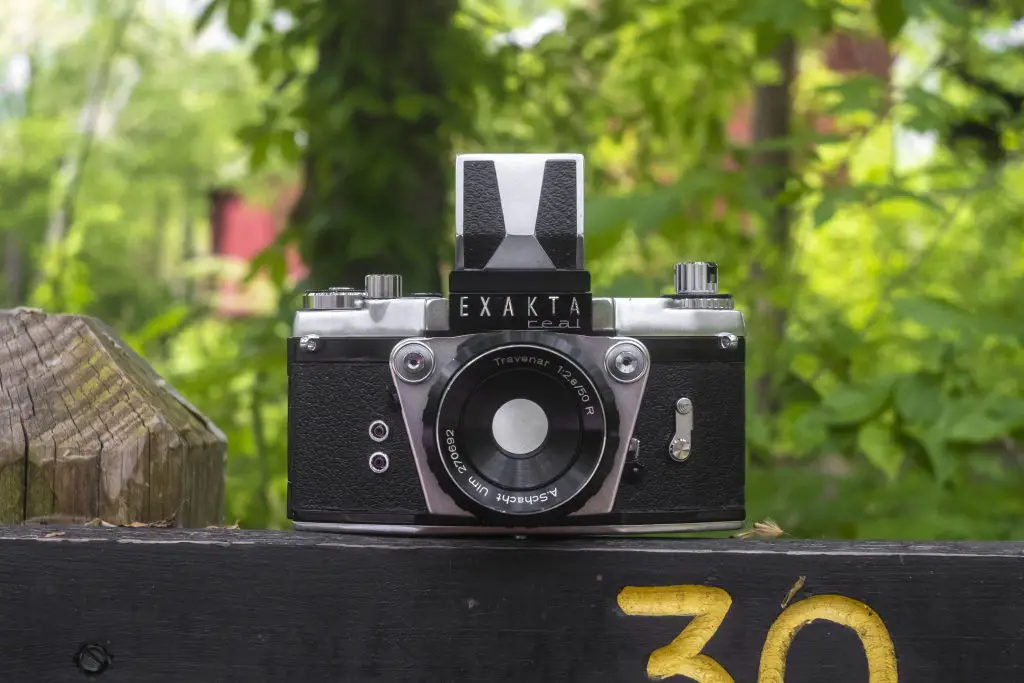 Film Type: 135 (35mm)
Film Type: 135 (35mm)
Lens: 50mm f/2.8 A.Schacht Travenar coated 4-elements
Lens Mount: Exakta Real Bayonet
Focus: 0.5 meters to Infinity
Viewfinder: Interchangeable Waist Level Reflex Viewfinder
Shutter: Cloth Focal Plane
Speeds: T, B, 2 – 1/1000 seconds
Exposure Meter: None
Battery: None
Flash Mount: PC Port F and X Flash Sync
Weight: 1080 grams (w/ lens), 833 grams (body only)
Manual: http://www.ihagee.org/WestD/WST6-realBroch66.pdf (in German)
Promotional Pamphlet: http://www.ihagee.org/WestD/WST3-realModenst66b.pdf (in German)
How these ratings work |
The Exakta Real was an attempt at “rebooting” the Ihagee Exakta with several key improvements. Despite these improvements however, the camera was not successful and was produced for a very short time. A combination of not enough improvements, a very high price, and a target audience that didn’t exist, the camera went out of production quickly. In use, the camera works fine, and produces excellent images even with the base Travenar lens. I have always been fond of the original Dresden Exaktas, and with this camera’s improvements, it should have been a winner, but sometimes less is more. | ||||||
| Images | Handling | Features | Viewfinder | Feel & Beauty | History | Age | |
| 2 | 1 | 1 | 1 | 2 | 2 | 20% | |
| Bonus | none | ||||||
| Final Score | 10.8 | ||||||
The name “Exakta” is one of the longest lived camera names of the 20th century. With a production run from 1933 to 1988, the number of Exakta cameras is vast and far beyond the scope of this article. One of those Exaktas is the Exakta Real, which when it was released in 1966 was an offshoot of the original model in an attempt to modernize the marque and recapture some of it’s past glory. Before I continue the Real’s story, we should start at the beginning.
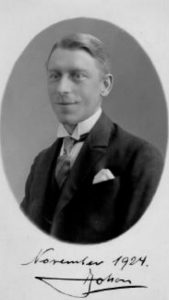
Ihagee was founded in 1912 by a Dutchman named Johan Steenbergen as Industrie-und Handelsgesellschaft which stands for Industry and Trade Society. Often referred to by the nickname IHG, the company name was eventually shortened to Ihagee Kamerawerk since Ihagee is pronounced the same in German as saying “I H G”.
In the early years, Ihagee produced a variety of plate and roll film cameras, but many were sold as “white label” designs for other manufacturers or distributors. There were some branded cameras sold under the names Photorex and Coronoa, but a large number of early Ihagee cameras were not labeled with a name, making identifying early Ihagee cameras very difficult.
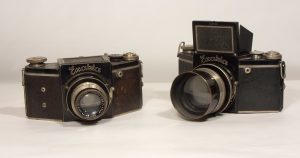
In 1933, Ihagee made its first significant splash in the camera industry releasing its first “miniature” camera which they called the Exakta. This first Exakta took 4cm x 6.5cm images on 127 roll film and was the world’s first compact Single Lens Reflex camera. In 1936, Ihagee would release a revised variant designed for the new 135 format 35mm film, which they called the Kine Exakta. The word “Kine” was short for the word “cine” or “cinema”, and never appeared on the camera itself, but was used in literature to differentiate the 35mm film version from the original 127 roll film “Vest Pocket” Exakta.
The Kine Exakta was successful as it was the only camera of it’s type and inspired companies like Zeiss-Ikon and KW to begin work on their own 35mm SLR designs, both of which would not be ready until after the war.
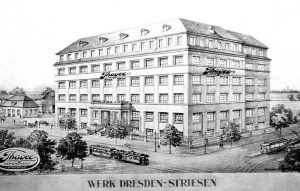
As early as 1939, Johan Steenbergen anticipated the possibility of losing control over his company to Germany’s Nazi government and took steps to isolate himself from a future takeover. That year he gave his accountant and friend Dr. Erich Glier power of attorney to act on his behalf in the event of his absence. In 1941, after a short imprisonment by the German government, Steenbergen split his company into two, separating the trademarks and business side from the rotating capital. A new company called Steenbergen & Company would own the land, buildings and machinery in an attempt to at least retain some ownership of his company after the war.
After it was becoming clear that staying in Germany was no longer safe, Johan and his American born wife Elizabeth fled Germany in 1942, first stopping in Lisbon, then New York, and finally settling in San Francisco where his wife had family. While in San Francisco, Johan Steenbergen attempted to represent the interests of his company, establishing relationships with other optics companies in an attempt to resume production of Exakta cameras under a new owner. Despite his best efforts, his attempt to restart Ihagee in America failed, and in late 1943, he took on a role in the Dutch consulate in San Francisco eventually being appointed as honorary consul.
After the war, because of his role as director of a large German industrial company, the Dutch government asked him to go to West Germany as a member of the occupying powers. There he was promoted to a Colonel in the Dutch military and served as an ambassador to the Dutch government with Allied countries.

In addition to his diplomatic responsibilities, Steenbergen hoped to return to Dresden to help rebuild his company. He had received word from Ihagee employees who remained in Dresden that although the factory was completely destroyed, many of the machinery and equipment had been rescued and relocated to a different facility. Unfortunately, the Soviet government denied Steenbergern’s request to return to Dresden and he was forced to stay in West Germany.

By the end of the 1940s, the Soviet government had appointed a trustee to supervise the production and sale of Ihagee products. This East German Ihagee retained many of the former employees, continuing to sell the pre-war Kine Exakta with an updated Exakta Varex model being released in 1950.
It appeared that Steenbergen’s decisions to split ownership of the prewar Ihagee into separate companies with a large amount of the capital owned by the Dutch government was a good idea as the Soviet government never nationalized Ihagee like they had done with Zeiss-Ikon and other Dresden area companies.
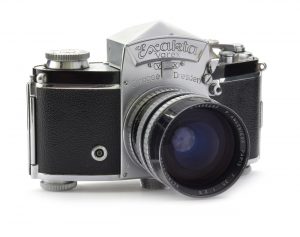
The East German government was reluctant to fully sever it’s ties with Ihagee’s Dutch roots as it was thought that it would negatively impact their trade relations with the neutral Dutch government and it’s allies. Throughout the rest of the 1950s, Steenbergen, using his influence with Dutch and other Western governments repeatedly fought to regain control over his former company and it’s trademarks.
Eventually, his persistence paid off and on November 30, 1959, Steenbergen forced his hand and ownership of the Ihagee corporation was transferred from Dresden to a new facility in Frankfurt am Main, West Germany. In the early 1960s, the new Ihagee West and Ihagee Dresden would co-exist and this sparked a large number of legal battles to be fought over Ihagee’s trademarks and properties.
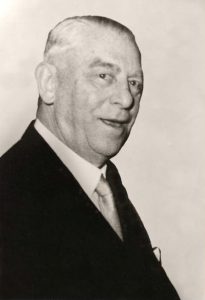
These legal battles were very expensive for Ihagee West and it slowed the new company’s ability to create new products, but by the end of 1961, the higher court in Frankfurt declared that the new company, now called Ihagee Kamerawerk AG owned the rights to the Ihagee, Exakta, and Exa trademarks and could use them on new products. The company’s headquarters were also moved to West Berlin.
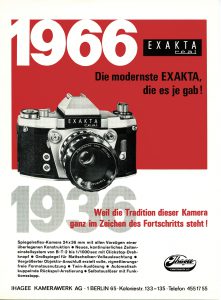
The next year, work began on an all new Exakta camera. By this time, the original Exakta was approaching three decades old and many of the camera’s best features were considered outdated and superseded by new designs coming out of Germany and Japan.
At Photokina 1963, six prototypes of a new Exakta camera were presented which revealed a similar trapezoid body, but with an all new and larger lens mount, an instant return mirror, interchangeable viewfinders, and TTL metering. For reasons I could not discover while researching this article, the new Exakta was poorly received and the camera would be redesigned by Helmut Knapp and would not surface again for another three years.
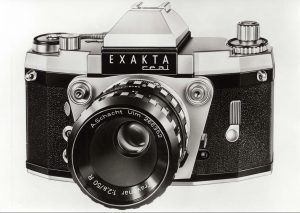
In July 1966, the Exakta Real would make it’s debut at a press conference with models going on sale later that year. Most of the new features from the original prototype were retained except for TTL metering.
Of the many improvements in the Exakta Real over the original model was the new lens mount. A new bayonet mount with an 46mm wide internal diameter, the Real’s mount was not only larger, but also supported an internal linkage for stopping down the lens, allowing for open aperture viewing through the viewfinder. The larger size also meant that faster and wider angle lenses could be used as the narrow opening of the original mount limited the use of these lenses. Not willing to totally turn their back on the huge selection of existing Exakta lenses, Ihagee West produced an adapter which allowed original Exakta lenses to be mounted to the Real. With support for the left handed shutter release, this meant that the external linkages would work as well.
Perhaps foreshadowed by the camera’s early problems, the Exakta Real did not sell well. The camera was extremely expensive and was plagued with reliability problems. In a German price list from 1966, an Exakta Real with waist level finder and A.Schacht Travenar f/2.8 lens cost 860 DM. When equipped with a Schneider-Kreuznach Xenon f/1.9 lens, the price rose to 996 DM. Comparatively an East German Exakta Varex IIB with a waist lever finder and Carl Zeiss Tessar f/2.8 lens cost 559 DM. The same camera with a Zeiss Pancolar f/2 lens cost 592 DM. With prices approximately 60% higher than an equivalent Exakta Varex, which itself was already an expensive camera, sales were slow.

A total of 13 lenses were available in the Exakta Real mount by either Schneider-Kreuznach or A.Schacht, from a 28mm f/4 Schneider Curtagon to a 80-240mm f/4 Schneider Tele-Variogon zoom lens. The above image shows four of these lenses, the 28mm Schneider Curtagon, 35mm Schacht Travegon, 50mm f/1.8 Schacht Travelon, and 90mm Schacht Travenar. To the best of my knowledge, the Exakta Real is one of the only German built cameras to never have a Zeiss lens produced for it’s mount. For people wanting to use a lens not natively available in Exakta Real mount, there was an original Exakta to Exakta Real adapter that could be used.
Ihagee West put a lot of effort into promoting the Exakta Real, creating several full page informational brochures like the one below. Detailed descriptions of all 13 lenses with the Exakta Mount were included, as were images and descriptions of other accessories like bellows and microscope attachments.
This 20-page promotional pamphlet was kindly donated to me by Rudi Hillebrand of photodeal.de.
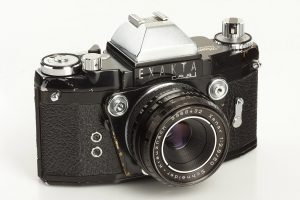
The Exakta Real was produced for just two years and by 1968 was discontinued. In an effort to try and turn a profit, Ihagee West tried their hand at a few other cameras including their own version of the Exakta 66, a medium format SLR that used the Pentacon Six mount, and a few other models.

In 1970, still suffering from the sting of the Exakta Real’s failure, Ihagee West would try to salvage the Real’s lens mount with a new 35mm SLR called the Exakta Twin TL. In an effort to reduce costs, the Twin TL was produced in Japan by Petri.
The Exakta Twin TL was a Japanese camera through and through, with the only vestiges of it’s once great German lineage in it’s name and lens mount. Once again, it did not sell well. It sold so poorly in fact, that a variant of the camera called the Exakta Twin TL 42 was quickly released that replaced the Exatka Real’s mount with the “universal” M42 screw mount.
Despite a promising start, Ihagee West would not survive the 1970s, and it’s role in the history of 35mm cameras is but a small footnote compared to other companies.
I was unable to find any advertisements or articles about the Exakta Real in any of my usual resources, but I did find a brief mention of the camera in one of Jason Schneider’s regular Camera Collector column in the January 1980 issue of Modern Photography.
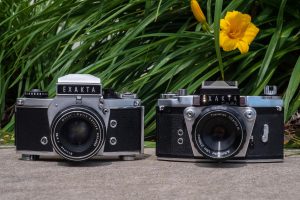
Today, the Exakta Real is an enigma. Although the camera is very different from the original Exakta, if you look quickly enough they bare enough of a passing resemblance to 1960s Dresden Exaktas such as the VX1000 that I’d be willing to bet some collectors don’t even realize they were different.
The camera was not successful upon it’s launch and so few were made that they rarely show up for sale today and when they do, the prices are all over the place. But if you like obscure and attractive looking German SLRs, this one checks all the right boxes for the serious collector.
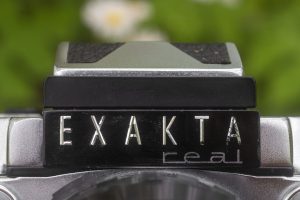
My Thoughts
The Exakta Real is a camera that is both very different from the original Exakta, and so similar that many people likely don’t even realize how different it is. When I was offered to review this camera from my friend Kurt Ingham, I knew exactly what it was, but when I went to brag to my camera blogger friends that I had one, the reaction to it generated no excitement. I get the feeling that at a glance, when someone sees an Exakta Real, they hear “Exakt…” and lose interest. That’s not to say Exaktas are bad cameras, because they’re not, but in the collector’s world, they’re extremely common.
Hopefully anyone still reading this review has at least seen how different they are, and knowing that, you’re probably wondering why you haven’t heard about them sooner. In my opinion, there’s two answers to that question, the first of which has largely been answered in the section above when I mentioned that the cameras were very expensive, and plagued with production problems, seemingly from the moment they were first announced. The second though requires you to keep reading.
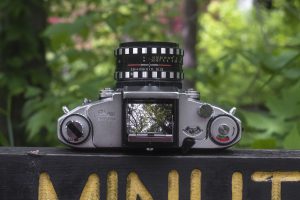
From the top plate, we see the original Exakta’s familiar trapezoid body. I imagine that the designers of this camera intentionally wanted to retain this shape as an homage to the original, but for me, this is the very first mistake made with the Real. I mentioned in my review for the Exakta VX that I didn’t care for the shape as the slanted sides make the camera very difficult to maintain a firm grip on while holding.
I never recommend taking any camera out for any kind of extended shooting adventure without some kind of neck or wrist strap and that’s even more important with Exaktas. When your fingers are gripping the body without a strap, the shape of the body makes your fingers want to keep sliding back and towards the edge, exactly where you don’t want it to be. In 1933 when the very first Vest Pocket Exakta was created, I could forgive this design decision as people didn’t know better, but by the 1960s when this camera was being designed, the people at Ihagee West had three decades of experience to know what works and what doesn’t. There was a reason no other company made trapezoid shaped camera bodies and it’s unfortunate the Exakta Real kept with it.
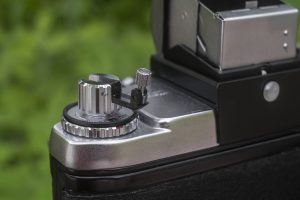
Moving aside from the body, the rest of the top plate is very un-Exakta like, with it’s relatively normal location of controls. A normal looking rewind knob has a double fold out handle that retracts nicely into the knob when not needed. Beneath the knob is a metal ring with a black plastic trim around the top. Turning the black plastic trim changes what appears in a small rectangular window and functions as a film type reminder. The Exakta Real is a meterless camera, so this dial is simply a reminder.
The chrome part of that ring is an unlock for the release mechanism for the door. Turning this ring doesn’t actually open the rear door, it just allows you to pull up on the rewind knob to actually open it. Other companies like Nikon and Zeiss-Ikon with the Contarex have used a two step system like this to prevent someone from accidentally opening the film door with film loaded in the camera. I am fine with a two-step process, but the implementation here is not at all obvious and requires you to read the manual first. Without a manual (or an article like this one), I would suspect that many first time Exakta Real owners struggled to figure out how to open the camera.
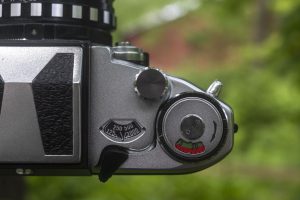
On the right side is the shutter speed dial, shutter speed display, and film advance lever with combined exposure counter. The exposure counter does not manually reset and has a clever color coding system in which upon resetting it to 0 for a fresh roll of film, the background to the numbers are in green. As you keep shooting, a sliver of red appears, to indicate that you’re getting closer to the end of the roll. The more exposures you make, the more red and less green you see until the background is entirely red at the 36th exposure. This isn’t as effective when using a 20 or 24 exposure roll, but still, the thought was nice.
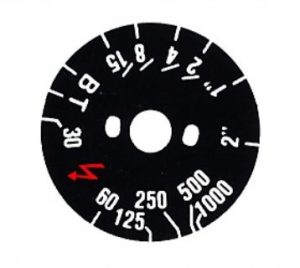 It is hard to see in this picture, but the design of the shutter speed knob is strange. It is very narrow and tall. While that makes it easy to grip, it can get snagged easily and turning it to change shutter speeds is almost too easy as accidental changes to the shutter may happen.
It is hard to see in this picture, but the design of the shutter speed knob is strange. It is very narrow and tall. While that makes it easy to grip, it can get snagged easily and turning it to change shutter speeds is almost too easy as accidental changes to the shutter may happen.
Although a standard sequence of shutter speeds is shown on the speed dial, they are not consistently spaced like you might expect from a 1960s camera. There are click stops in between some of them allowing you to choose some in-between speeds. Electronic flash sync is indicated with a red lightning bolt somewhere between 30 and 60, and strangely, both B and T modes are halfway between 15 and 30. When you’ve reached the fastest or slowest speed on the dial, you can keep turning it to go between 1/1000 and 2 seconds without having to go all the way around in the other direction, which I guess is useful for those times where your lighting suddenly changes from extremely bright to needing long shutter speeds.
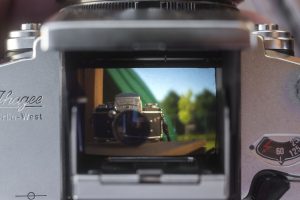
The viewfinder on the Exakta Real is completely different from that of the original Exakta. Not only is the opening slightly larger, but removing it simply requires pulling it towards the back of the camera where it slides out. In addition, the focusing screen is on the camera itself, rather than the viewfinder like the Dresden Exaktas.
When it was sold, a pentaprism viewfinder was available, but the one I had available for this review only had the waist level finder. While using it, the viewfinder was very bright with good corner to corner brightness. The focusing screen was just a flat piece of ground glass, with no split image or microprism focus aides. There was also no other information in the viewfinder such as selected shutter speeds or f/stops. Not shown in the previous image, but there is a hinged magnifying glass that can be flipped up for precise focus which was helpful for closeups.
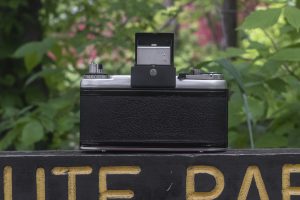
The back of the camera shows nothing terribly exciting, unless you like looking at the release catch for the pop up viewfinder lid.
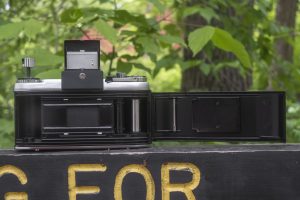
Earlier I mentioned the somewhat confusing process for opening the right hinged film door, but once it’s open, you’ll see a rather ordinary looking film compartment. The door is not removable, eliminating any chances for some kind of bulk or data film back which might have helped the camera appeal to more professional photographers.
Unlike the Dresden Exakta, film transport is from left to right onto a fixed take up spool. This means the Exakta Real loses the ability for cassette to cassette transport which by the time the camera was released, likely wouldn’t have been seen as a big deal. The film pressure plate is smooth metal and has notches on the top and bottom that rest in a similarly sized indentation above and below the film gate, to help with film flatness.
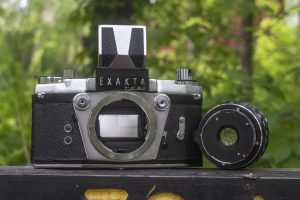
Up front we see the two shutter releases, one on the left and one on the right, giving the camera a pleasing symmetric look. Near the 3 o’clock position around the lens mount is the lens release lever. To the right of it is the self-timer.
Removing and attaching a lens on the Exakta Real is quick and easy, like you’d expect from any SLR with a bayonet mount. On my example, the lens attached firmly with absolutely no play suggesting a precise mount that should have been able to handle many different lens swaps. As mentioned earlier, there was an optional lens mount adapter which would have allowed you to use original Exakta lenses on the Real, but I didn’t have access to one.
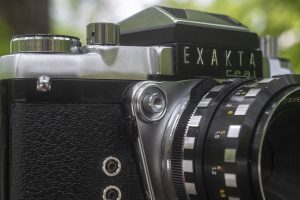
Both shutter releases can be used to trigger the shutter, and both are threaded for a cable release. Immediately below the right handed shutter release is a small black lever which acts as a shutter lock. Although this lock is only on one side of the camera, activating it will lock both sides.
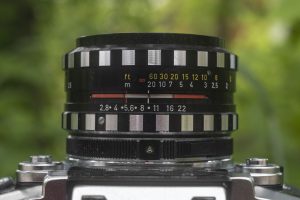
The 50mm f/2.8 A.Schacht Travenar that was on this camera was sold as the entry level lens, but despite this, is quite nice in construction.
Featuring a familiar “Zebra” style that was common among German lenses in the 1960s, the lens has a clever depth of field scale in which an unpainted line is flanked by two red lines that indicate the limits of the depth of field at a particular f/stop. Open up the lens to a wider aperture and the unpainted section shrinks, stop down the lens and it increases in size.
Both the focus and aperture rings are sufficiently large and easy to grip. The aperture ring has prominent click stops that make changing f/stops very easy to do with the camera to your eye. The letter “A” indicates the lens is in Auto mode and can be changed to Manual mode which allows you to preview depth of field.
This camera came to me only with the waist level finder, so I am unable to show you a view of the pentaprism viewfinder, but considering there was no shutter speed, aperture, or exposure information within the viewfinder, there wouldn’t have been much to see.
Using the Exakta Real was quite pleasant. While the success of the camera was questionable, the West German designers did a good job at locating all the camera’s controls in a logical and comfortable location while shooting. The lens on this camera was the entry level A.Schacht Travenar, but how did it shoot?
My Results
I shot two rolls of film through the Exakta Real. The first roll was fresh Kodak 400TX which I took out on a late winter day and after developing it, noticed that throughout the first half of the roll, the shutter had some lag, blocking half of each exposure. As the roll went on, the issue went away, suggesting this camera hadn’t been used in long enough time that it just needed some exercise.
After dry firing the camera 20-30 times and feeling good that the shutter was working, I loaded in a roll of Kodak Portra 160 and shot that. Thankfully, the shutter issue did not return and I got a whole roll of properly exposed images.
The Exakta Real was an expensive German SLR, and like most expensive German SLRs, the expectation of good images was quite high, and looking at the gallery above, I guess I shouldn’t be surprised that they all turned out nicely exposed, with good corner to corner sharpness, and none of the typical optical anomalies associated with lesser lenses.
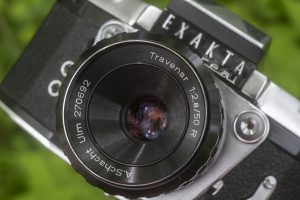
But this Exakta Real, with it’s f/2.8 A.Schacht Travenar lens didn’t quite inspire as much confidence had it had something by Carl Zeiss or Schneider-Kreuznach. My experience with A.Schacht lenses has typically been in lesser cameras with “good but not great” images. So I guess I was a bit surprised at how well it performed here. When Kurt first alerted me to this Exakta Real, he was quick to point out that it “only” had a 2.8 Travenar, but after seeing the results, I can honestly say that other than lacking a stop of brightness wide open, in the situations I shot it at stopped down, the lens is not deserving of it’s “yeah but…” reputation.
While the lens performed great, the rest of the camera was a mixed bag. The waist level viewfinder worked as well as you’d expect any to work on a regular Exakta, Nikon F, Miranda, or any other SLR with an interchangeable viewfinder. The viewing screen was bright and had a split image focus aide in the center which made precise focus very easy.
The right handed controls were more convenient than they are on Dresden Exaktas, but the film advance was stiffer than I would have liked and changing shutter speeds was a bit odd as the gap between speeds varied depending on what speed you were selecting. For example, the gap between 500 and 1000 and 500 and 250 is very small, the gap between 250 and 500 is twice as big with an unmarked click stop in between, and the gap between 60 and 125 is about 4 times as wide with two unmarked click stops between. This all but eliminates changing shutter speeds by feel, requiring you to look down at the top plate to make sure you have the correct speed selected.
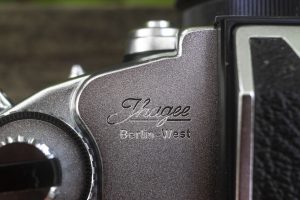
By far, my least favorite feature of the camera was the shutter release lock which is in a location just below the right handed shutter release button. I found that while carrying the camera, the shutter lock was constantly being activated, requiring me to fiddle with it before being able to fire the shutter. It’s a good thing I didn’t try to take any spur of the moment shots with the Exakta Real as this would have no doubt caused me to miss the shot numerous times. This being the only Exakta Real I’ve ever handled, perhaps this one is just really loose and maybe it’s supposed to be less accident prone, but I have to imagine it’s location so close to the shutter release probably meant this was an issue on all Exakta Reals.
The existence of the Exakta Real is rather confusing. I fully understand the need to modernize the original Exakta. By the 1960s, the left handed controls, backwards film compartment, and trapezoidal body shape were seen as primitive relics of the 1930s when the first camera was designed. The original Exakta bayonet mount lacked the ability to internally stop down a lens and was very small, meaning that developing very fast or wide angle lenses was not possible. The decision to come up with an all new and larger bayonet with an internal diaphragm linkage was a good one not only to open up the doors for more lenses, but also to add strength to the lens mount for supporting heavier lenses and eliminate the bulky external buttons that were common with “Automatic” Exakta lenses.
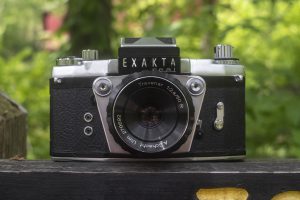
But where Ihagee West really failed with this camera was that it in no way met the needs of a professional photographer like the Dresden Exaktas once did. By the time of it’s release, the Exakta Real failed to significantly modernize the original camera in a meaningful way. There was no provision for an in-body meter (not even a clip on one that many companies at the time were using), the lack of a removable film door meant that no bulk film backs or those with data backs could be swapped. There was no provision for a motorized film transport which would have been a big deal to a pro photographer. Finally, while the new lens mount was an improvement over the original Exakta mount, by 1966 it had only barely met the minimum requirements of a modern lens mount. There was no ability to automatically index the lens for an exposure meter like Nikon, Minolta, or even Canon were doing at the time. Had the Exakta Real been a success, the lens mount would have needed upgrades almost immediately to stay competitive.
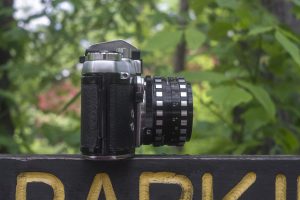
This brings into question who the target audience for this camera would have been. The lack of the features I described above all but eliminated professional and scientific applications, and the camera’s astronomical price meant that amateur and family photographers would have seen it to be too expensive. The camera might have been able to gain some support had it been released in East Germany or the Soviet Union where cutting edge technology was not always a requirement, but this was a West German built camera, which means it would have needed the support of western countries like the United States who already had a huge variety of excellent Japanese cameras to choose from that had better features and were less expensive.
A combination of a high price, the lack of features pros wanted, it’s inability to compete with the wide variety of Japanese cameras available to western photographers, and with it’s poor reputation for reliability, the Exakta Real was a failure upon launch.
As a collector today however, the Exakta Real is extremely fascinating. It’s good looks and “one and done” history make it appealing to me. It’s owner was fortunate to find this nice looking and fully functional example, and I did enjoy shooting with it. I’d love to tell you all to go out and get one, but these cameras are extremely hard to find, so that’s not likely to be an option for most people reading this article. If however, you are lucky enough to find one at anywhere remotely close to an affordable price, it is worth considering for it’s curiosity factor, just don’t expect to fall in love with shooting it.
Related Posts You Might Enjoy
External Links
http://camera-wiki.org/wiki/Exakta_Real
http://www.ihagee.org/ihageeWD.htm
http://www.exakta.org/orgarticles/orgrealaguila.html
http://www.steenbergen-stichting.nl/index.php?pagina=BIOGRAFIE

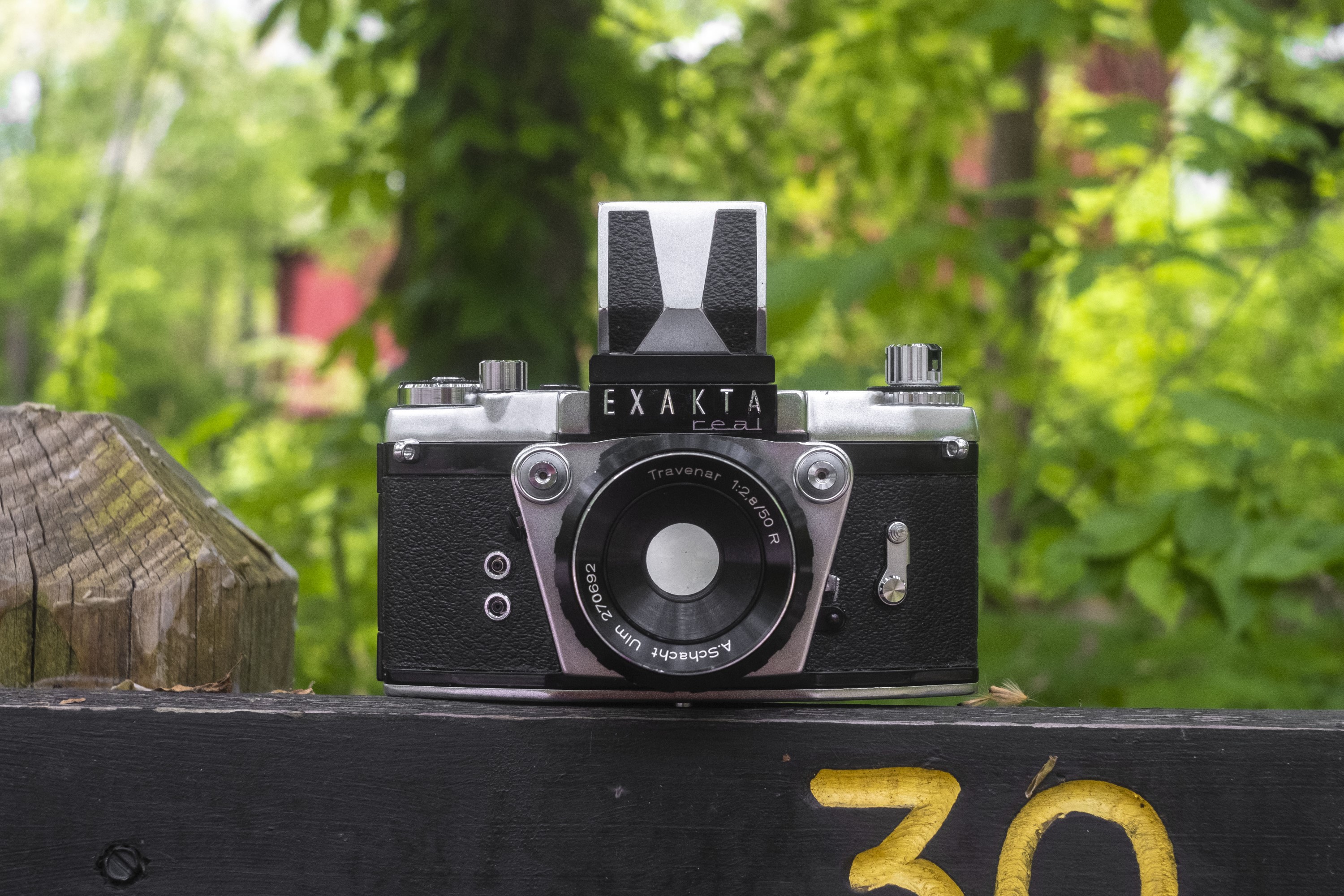
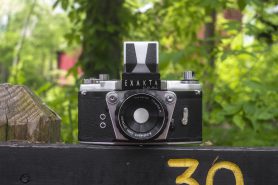
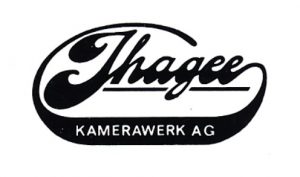
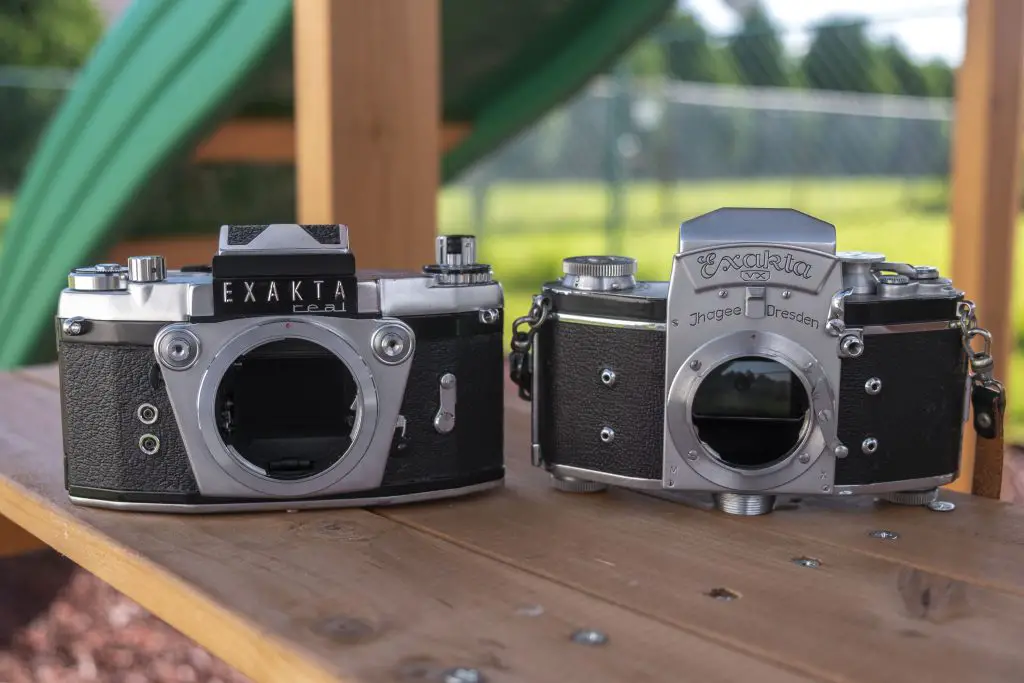
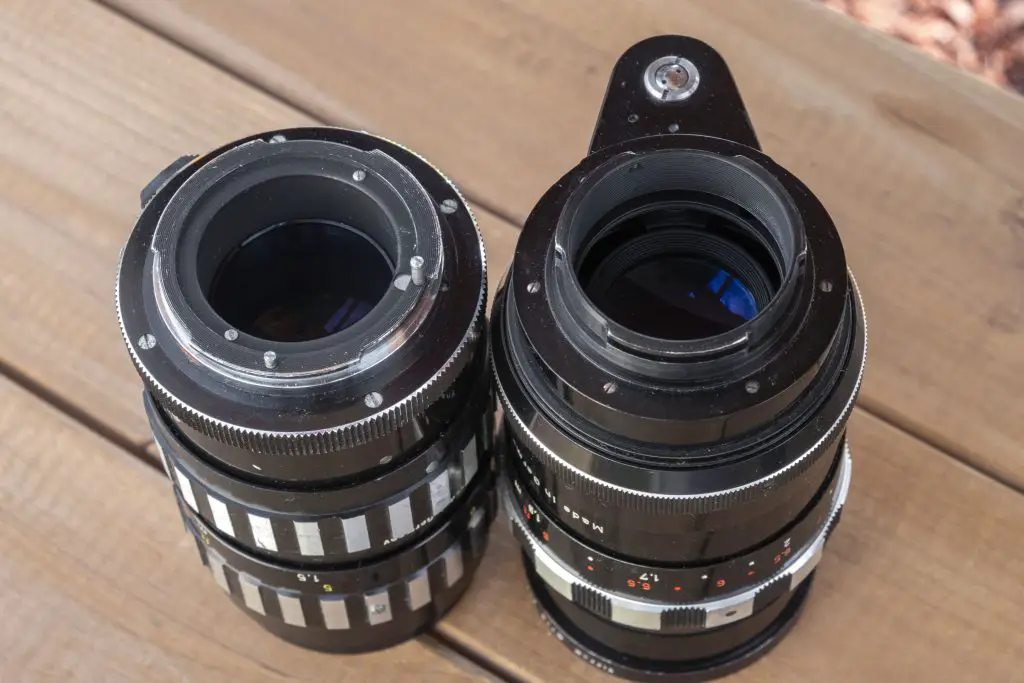




















You’ve just reviewed a remarkably rare camera, one that most diehard Exakta collectors would love to personally try. Ihagee West, as a company, is said by some in the business to have failed thanks to the uncaptured costs of development of this camera. Based on my experience with several examples, avoid the Twin TL … as with nearly anything made by Petri, it is unreliable. BTW: There was a very successful camera family with trapezoid bodies (albeit reversed front-to-back): the Bolsey 35mm rangefinder models B, B2, and the TLR model C.
Very informative and revealing review. Exacta occupied a remote area of my awareness for the very similar reasons you attest. Thanks for pursuing this camera and the history research needed to bring it to light!
I used to own an Exakta Real which I had purchased used back in the 1970s for a very low price from a camera store in Los Angeles. Sadly, during a long stint of under-employment, I had to sell it, along with several rare lenses in the old standard Exakta mount. During the time I had it I only ran a few rolls of film through it, and yet I had to have the shutter repaired twice. The technician who worked on the shutter said it was very difficult to repair and he was reluctant to offer any guarantee on his work. He felt the mechanism was poorly designed. I think I read somewhere that the man who designed it had also designed the Edixa SLR…not a highly regarded camera. The lens on my copy of the Real was an A. Schacht Travelon 50mm f1.8. To my great surprise, the lens was magnificent. In fact it had great contrast and I think it was sharper wide open than my Schneider Xenon 50mm f1.9 or my Zeiss Jena Pancolar 50mm f2.0. Based on your experience with the 2.8 Travenar I wonder if the Schacht lenses aren’t due for a revaluation among collectors. I sure was sorry to sell the camera, but truthfully I never use any of my Exaktas any more. These days I only use film in my medium format cameras. All my smaller SLRs are digital. The old Exakta lenses work great on my Lumix, though!!
Great story, Hugh! It is such a shame that Ihagee West couldn’t find a way to reboot the Exakta with a more reliable, and less expensive camera. The Exakta Real is certainly cool, and I am happy to have been able to shoot it, but I agree with you that it likely wouldn’t have made for a very good long term camera.
Wow! I had pegged the Zeiss Ikon Contarex as the most foolish German SLR project, but the Exakta Real changed my mind. At least the people behind the Contarex had an idea of what they were facing in Japan – the Exakta’s designers seem to have spent the time between 1945 and 1966 in a coma XD
It might be worth mentioning that “Varex” was an Argus trademark in the US. Varex lenses were used on Argus twin lens reflex cameras from 1940 (Argoflex E) to 1954 (Argus 40).
Yep, this is the reason why the Exakta Varex was sold as the VX here in the United States.